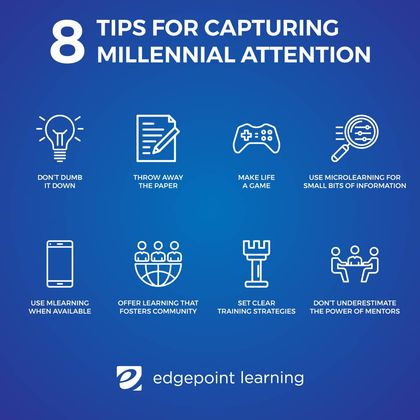Capturing Millennial Employee Attention In a World Where We Work from Anywhere
Corey Bleich
🍿 5 min. read
Millennial employee attention can seem like a moving target. If you believe the hype of people who don’t know better, capturing (and keeping!) the attention of millennial employees can seem a Sisyphean task. Many of the strategies for professional development and workplace management that worked for Gen Xers and Baby Boomers just don’t resonate with the demographic born somewhere between the early 1980s and late 1990s. Projected to be 75% of the workforce by 2025, however, millennial employees simply learn and work differently. Companies that want to engage and retain this growing part of the workforce need to know what drives them, what we can learn from them, and how to capture their attention in a world where we work from anywhere.
Beyond the stereotypes: What drives millennials?
What motivates millennial employees may not be the same things that drove other generations to success, but don’t write them off.
Millennials may seem like they are more play than work, but that’s just not the case. Millennial employees are all about a different kind of work that is just as productive and important as your dad’s desk job.
It’s not about entitlement: Millennial employees just need a reason to go to work
Beyond financial gain, millennials want to feel like what they do matters.
A white paper by the Center for Generational Kinetics noted that 60% of millennials chose their work because they felt they made a difference.
They want technologically-savvy workplaces
This generation of digital natives isn’t satisfied with basic internet surfing in the course of their job. For learning and collaboration, they want to use:
- Social media networks
- Gamified courses
- Video, on-demand and interactive
- Blogs
- Virtual and augmented reality
- Mobile learning
- Microlearning
Not your parent’s science project: Millennial employees expect group work
This is not a generation that wants to go to work, put in their 40 hours a week, and then get a gold watch after 30 years. They are looking for employers that offers the following benefits:
- Flexibility: A nine-to-five schedule may not suit millennials; work-from-home and flexible work schedules are key to attracting and retaining them.
- Responsiveness: Employers that are responsive and provide regular feedback and encouragement are a boon to millennial employees. A year-end review won’t work for this generation; they want to know they are on the right track with regular, encouraging feedback, even when it is critical.
- A work-life balance: Millennials crave a solid work/life balance (rather than just financial reward). They don’t want to live for work OR work to live; they want both in equal measure.
- Advancement: Career mobility should be individualized, not a set structure that takes everyone the same period of years. Reward merit and hard work, and millennials will surpass your expectations.
- Training tailored to their learning style: No more endless conferences with PowerPoint presentations. Make use of innovative, microlearning moments to capture their attention.
These criteria may seem at odds with the traditional corporate structure, and, to a large extent, they are. The fact remains that this young workforce will shape the way in which businesses operate, and it’s important to meet them where they are. Besides, who wouldn't want a more flexible, balanced, rewarding, and fun work life?
Companies like Apple and Google have a large and mobile millennial workforce that is already changing their corporate culture (naps, free haircuts, and data-based decision making, anyone?), resulting in more productive and profitable organizations.
8 tips for capturing millennial attention
Offering variety, constant feedback, and a work environment that is flexible and engaging is just the beginning. Here are eight more ways to capture millennial attention.

1. Don’t dumb it down
Just because information is delivered differently doesn’t mean it needs to be watered down or oversimplified.
Revisit training materials to see if you are making negative assumptions about millennial employees, then find ways to make them more meaningful, valuable, and relatable.
2. Throw away the paper
Millennial employees are digital natives. Don’t hand them a 3-ring binder as a training manual unless you want to see it being used as a doorstop.
Keep training tools agile (and earth-friendly) by ditching the binder and making the majority of your employee training electronic.
3. Make life (and corporate training strategies) one big game
Millennial employees want to know they are on the right track more often than an annual review.
Training that incorporates rewards through gamification fits in with the millennial status as digital natives. It also positively reinforces what they're doing well, while offering feedback on what might be done better in a more light-hearted way.
4. Use microlearning for bite-sized nibbles of information
A short, information-packed video delivered to any mobile device will be a more effective training tool for millennial employees than a full-day seminar in a conference room.
Millennials are also more likely to access this information after hours and to revisit it when needed.
5. Use mLearning for larger bites
mLearning is an electronic training tool that can replace those clunky 3-ring binders. Think manuals, process-oriented information, and regulatory updates for this type of learning.
Millennial employees can access this just-in-time training whenever they need a refresher on a procedure.
6. Offer learning that fosters community
Sometimes training should feel like going out for a beer with friends.
Creating online communities that utilize forums to discuss issues, deliver information, and solve problems feeds the millennial desire for collaboration, social networking, and digital training all in one place.
7. Set clear training strategies for millennials that include multiple paths
Millennial employees want what feels like personalized choices in their trainings.
eLearning programs that offer multiple points of entry and opportunities for further study are well-suited to a generation that wants to feel like their contribution is meaningful and valued.
8. Don’t underestimate the power of mentors
Because millennial employees value (nearly) constant feedback and personalized training, mentors can be an important part of capturing millennial attention.
Properly trained mentors can also help bridge the gap between generations in a company that wants to change but needs some help.
Engaging millennial employees in the modern workplace can take some doing, but we're here to help at EdgePoint Learning. Get in touch today to discuss training your different employee populations.
This article was originally published on eLearningIndustry.com on November 17, 2017.
